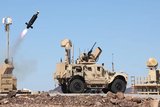T-6 Texan II trainers deepen their footprint in Asia
Japan is buying 36 T-6JP Texan II trainer aircraft from the US. Shown here is a T-6C belonging to New Zealand. (Photo: Gordon Arthur)
The T-6 Texan II from Textron Aviation Defense has been selected by the Japan Air Self-Defense Force (JASDF), along with associated ground training equipment, as its new basic trainer aircraft.
Chuck Gummow, Asia-Pacific regional director for new aircraft sales at Textron Aviation Defense, told Shephard at the Vietnam Defence Expo 2024 in Hanoi that Japan would obtain a trainer variant called the T-6JP, which builds upon the baseline of the T-6C.
This configuration will feature certain modifications compared to the current T-6C export model, these being in common with a new-generation T-6 variant expected to be announced by Textron next
Already have an account? Log in
Want to keep reading this article?
More from Air Warfare
-
![How do we detect and defeat enemy drones?]()
How do we detect and defeat enemy drones?
Learn about the portfolio of sensors and effectors for the complete counter-UAS mission at Raytheon, an RTX business.
-
![BAE Systems lauds counter-UAS drone progression with live fire trials]()
BAE Systems lauds counter-UAS drone progression with live fire trials
The US-based tests successfully demonstrated the first live trial of a precision guided missile from a modified TRV-150 drone which destroyed both aerial and ground targets.
-
![Kratos Defense makes European CCA push with Airbus partnership]()
Kratos Defense makes European CCA push with Airbus partnership
Kratos’ XQ-58A Valkyrie will be equipped with an Airbus-made mission system to be offered as a ‘European’ collaborative combat aircraft option to the German Air Force.
-
![Anduril’s Barracuda-100M completes latest successful test flights]()
Anduril’s Barracuda-100M completes latest successful test flights
The munitions variant of the Barrauda-100 autonomous air vehicle is being tested for the US Army’s High-Speed Manoeuvrable Missile (HSMM) testbed programme, with further flight tests expected in 2026.






















